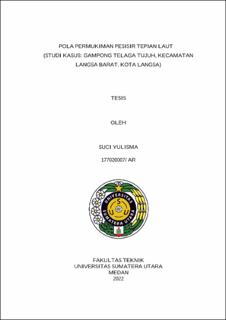| dc.description.abstract | Indonesia is an archipelagic country whose sea area is geographically two-thirds larger than the land, where almost every island has a coastline approximately 81,000 km long. Settlement is one of the basic human needs.Community priorities vary widely because of their different incomes and outlook on life. Some people survive imbalances depending on their situation of needs and current circumstances.Gampong Telaga Tujuh has an area with settlements inhabited by residents which is a land area of 6.26 hectares, has a high potential of natural resources, especially in the fisheries and marine sectors. It is not uncommon for this area to experience sea level rise so that sea water enters the land which can affect settlement and environmental conditions. The dependence of the community on the beach will affect the pattern of waterfront settlements.
Human activities that increase along with the development of the area also affect the shape and pattern of coastal settlements in Gampong Telaga Tujuh. The purpose of this study is to determine the characteristics, shape of settlement patterns, and to determine the causes of the formation of coastal settlement patterns on the seashore. In this research, descriptive quantitative research method is in the form of research with a case study method or approach.
The results showed that the characteristics of the Telaga Tujuh Gampong settlementis a waterfront settlement with the majority of the population working as fishermen with inadequate infrastructure conditions. The topography of the settlement of Gampong Telaga Tujuh has formed an area with a building on stilts above the water level, an area of tidal water transmission and a land area with the orientation of the building facing the road, facing the sea and facing the back of the building. The settlement pattern of Gampong Telaga Tujuh is a linear pattern of parallel buildings following the road network, as well as cluster or group settlement patterns.The cause of the formation of settlement patterns at Telaga Tujuh Village is caused by economic factors of the community as a fisherman as well as human or cultural interactions with nature, namely the sea. | en_US |

